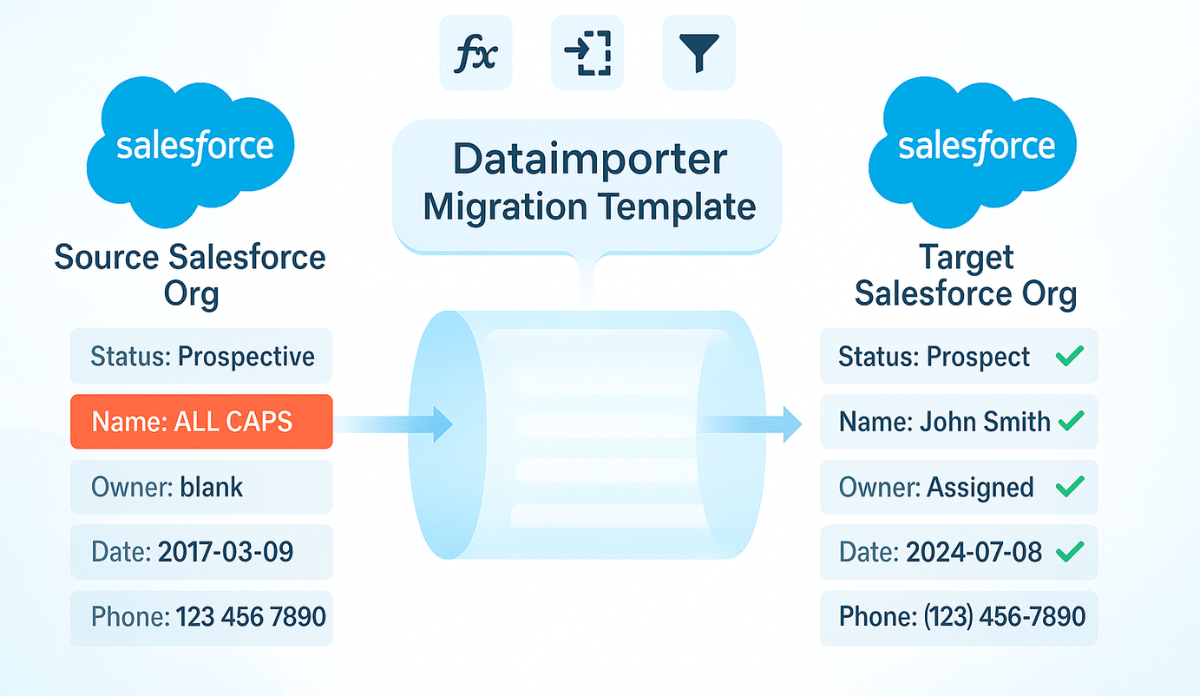Essential Data Transformations for Successful Salesforce Org-to-Org Migrations



Migrating data between Salesforce orgs is rarely as simple as a “lift and shift.” Every Salesforce environment is unique—fields may differ, values might need normalization, and relationships often require adjustment. Effective data transformation is key to a smooth migration, ensuring the new org receives clean, compatible, and business-ready data.
Below are some of the most common data transformations encountered during org-to-org migrations, and how you can handle them using Dataimporter’s no-code formulas.
When migrating between orgs, picklist or status values often differ. For example, “Prospective” in one org might be “Prospect” in another.
How to do it in Dataimporter:
Use the MAP formula to convert source values into the correct target values.
MAP([LeadStatus], {"Prospective": "Prospect", "Qualified": "Sales Qualified"}, "Other")
This ensures every status in your new org matches your business processes.
Sometimes the source org might store data in separate fields (e.g., First Name and Last Name), while the target org uses a single field (e.g., Full Name), or vice versa.
Combine fields:
[FirstName] + " " + [LastName]
Split fields:
To extract a domain from an email address:
SPLIT([Email], "@", 1)
Consistency in naming is important for reporting and automation. Standardize text to upper, lower, or capitalized case.
To capitalize account names:
CAPITALIZE([AccountName])
To convert to all uppercase:
UPPER([Region])
Some fields may need to be cleaned or re-assigned based on conditions.
Set owner based on region:
IF([Region] == "West", "0053X000002abcQ", "0053X000002xyzR")
Here, the OwnerId is set based on region, using Salesforce User IDs.
Flagging incomplete records:
IF(ISNULL([Email]), "Missing Email", [Email])
Migrating to a new record type or assigning a default value can be essential for new org structures.
Set a static Record Type ID:
"0123X0000012aBcQ"
Dates may require reformatting or offsetting, such as migrating only recent records or adjusting created dates.
Filter records created in the last 90 days:
to_datetime([CreatedDate]) > today() - timedelta(days=90)
Removing unwanted characters or whitespace is often necessary, especially for phone numbers or emails.
Remove spaces from email addresses:
[Email].str.replace(" ", "")
Remove all digits from a phone field:
[Phone].str.replace("\d+", "", regex=True)
Sometimes, data is missing in the source. You can set defaults or flag these for review.
Replace null with a default value:
IF(ISNULL([Industry]), "Not Specified", [Industry])
With Dataimporter, these transformations can all be configured as part of your Migration Template, ensuring that your data arrives in the target org clean and ready—without manual Excel work or Apex code. This means less risk, faster delivery, and more consistent results, even in complex multi-object migrations.
Ready to transform your next migration project? Start Using Migration Templates and formulas in Dataimporter or Request a Demo.
Key takeaway:
Proper data transformation isn’t just a technical detail—it’s the backbone of successful Salesforce migrations. With Dataimporter’s no-code approach, you can handle even complex scenarios with confidence and ease.